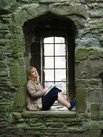Cartington Castle, Northumberland
Location | Cartington Farm 2 miles N.W. of Rothbury |
Road | off B6341 |
SatNav | NE65 7JW |
Cartington Castle began life as a late 14th century pele tower, the fortified home of the Cartington family who took their name from their residence. This was later extended to include the great hall and defended court-yard when granted to crenellate by the Crown. This picturesque ruins lay behind the farmhouse of the same name on a slope looking down on the River Coquet.
You will find this castle hidden behind a farm. With consideration you can park on the road with a short walk to the castle.
This has to be without doubt one of the most interesting ruins we have come across as both castle and settings are simply beautiful. A fantastic place to explore and well worth the visit.
~ History ~
1154 - Ralph Fitzmain is recorded as holding Cartington.
1421 - Cartington tower is extended to include a great hall and tower to defend the courtyard.
1442 - John Cartington is granted a license to crenellate Cartington.
1494 - The castle passes by marriage to the Radcliffe family.
1515 - Queen Margaret of Scots stays briefly at Cartington with Lady Anne Radcliffe after giving birth to her daughter at nearby Harbottle castle. The baby, also names Margaret, Lady Douglas, later marries the Lod of Lennox to become mother of Lord Darnley and grandmother of King James I.
1524 - Lord Dace stations his troops at the castle on a march to join the Earl of Surrey.
1529 - Sir Radcliffe is elected senior knight of the shire to parliament.
1537 - Sir Radcliffe is appointed as constable of Alnwick Castle following the fall of the Percy family.
1542 - Following Sir Robert Bowes expedition against the Scots, Sir Radcliffe is captured and taken into custody by the bishop of Glasgow. He is later released as one of the prisoners 'for the Kings purpose'.
1543 - Following many years of doubts cast upon Radcliffe's competence in raids across the border and defence of the borderlands, the crown draws up a list of fee'd men of Northumberland, listing Radcliffe as "a wise man well learned and well minded to justice but no adventurer to the field". Despite this vote of no competence he is awarded Captain of Berwick. The defences of the strategic important Berwick are later found to be insufficiently manned, organised and furnished.
1545 - Sir Radcliffe dies and is succeeded by George Radcliffe.
1648 - Local Royalist families, Widdringtons, Selbys, Claverings and other local families are besiged in the castle by parliamentary forces. The castle holds out for over two hours but is eventually taken and slighted. Despite some demolition, the castle continues to be occupied.
1680's - The Radcliffe's, who remain staunch Catholics, become Earls of Derwentwater, only to later lose the title as a Jacobite upon King James II fleeing to France and being replaced by his eldest protestant eldest daughter Queen Mary and his dutch husband King William III.
1860's - The castle is finally abandond.
